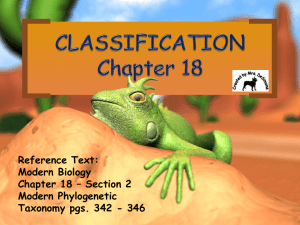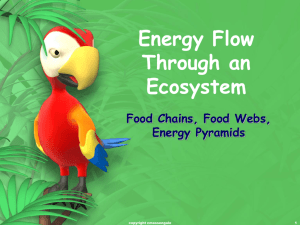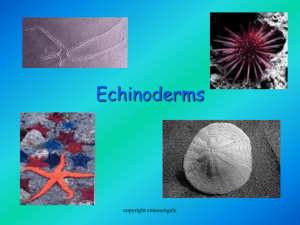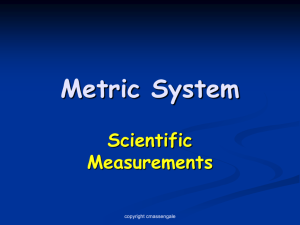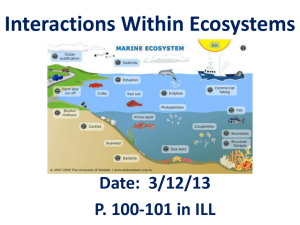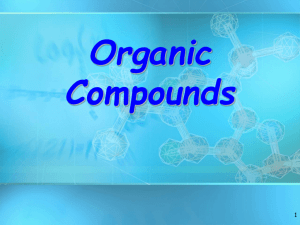Cell Biology: The Basic Unit of Life Presentation
advertisement
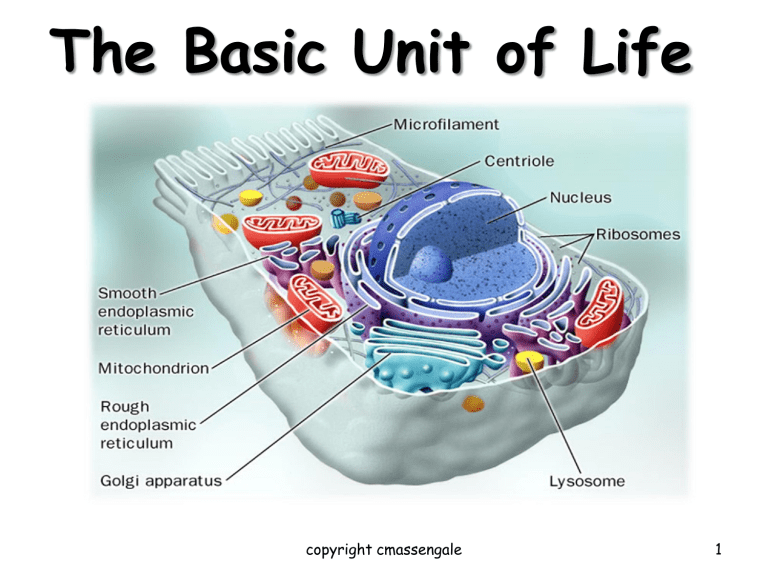
The Basic Unit of Life copyright cmassengale 1 Introduction to Cells • Cells are the basic units of organisms • Cells can only be observed under microscope • Basic types of cells: Animal Cell Plant Cell Bacterial Cell 2 Number of Cells Organisms may be: • Unicellular – composed of one cell • Multicellularcomposed of many cells that may organize copyright cmassengale 3 Cells May be Prokaryotic or Eukaryotic Prokaryotes include bacteria which lack of nucleus or membrane-bound structures called organelles. Eukaryotes include most other cells & have a nucleus and membranebound organelles (plants, fungi, protist & animals) copyright cmassengale 4 Prokaryotes Nucleoid region contains the DNA •Cell membrane & cell wall • Contain ribosomes (no membrane) to make proteins in their cytoplasm copyright cmassengale 5 Eukaryotic Cell Contain 3 basic cell structures: • Nucleus • Cell Membrane • Cytoplasm with organelles copyright cmassengale 6 Two Main Types of Eukaryotic Cells Plant Cell copyright cmassengale Animal Cell 7 Cell Organelles • Very small size • Can only be observed under a microscope • Have specific functions • Found throughout cytoplasm copyright cmassengale 8 Organelles Found in Cells Examples of Organelles include: Endoplasmic reticulum (rough & smooth) – canals for movement Golgi Bodies – wrap & export proteins Nucleolus – makes ribosomes Lysosomes – digests & gets rid of wastes Ribosomes – makes proteins copyright cmassengale 9 Cell Organelles copyright cmassengale 10 Golgi Bodies • Stacks of flattened sacs • Have a shipping side & a receiving side • Receive & modify proteins made by ER • Store proteins. • Storage center. Transport vesicle copyright cmassengale 11 Ribosome • The ribosome is a large and complex molecular machine, found within all living cells. • They serves as the primary site of biological protein synthesis. • Ribosomes are the cell’s protein factories. Ribosome copyright cmassengale 12 Lysosome • Contain digestive enzymes • Break down food and worn out cell parts for cells • Programmed for cell death (lyse & release enzymes to break down & recycle cell parts) copyright cmassengale 13 Nucleolus Cell may have 1 to 3 nucleoli • Inside nucleus • Disappears when cell divides • Makes ribosomes that make proteins • copyright cmassengale 14 Endoplasmic Reticulum Transport materials through the cell Known as the highway of the cell. Smooth SER lacks ribosomes process lipids and carbohydrates in the cell Rough RER has ribosomes on its surface & makes proteins to EXPORT copyright cmassengale 15 Cell Powerhouse Mitochondrion ( mitochondria ) Rod shape Site of Cellular respiration 16 In Animal Cells Mitochondria Active cells like muscles have more mitochondria Burn sugars to produce energy ATP 17 Surrounding the Cell Cell membrane • • • Lies immediately against the cell wall in plant cells Made of protein and phospholipids Selectively permeable copyright cmassengale 18 Cell or Plasma Membrane Cell membrane • Living layer • Controls the movement of materials into and out of the cell • Selectively permeable copyright cmassengale 19 Cytoplasm of a Cell • Jelly-like substance enclosed by cell membrane Cytoplasm • Provides a medium for chemical reactions to take place copyright cmassengale 20 More on Cytoplasm Cytoplasm • Contains organelles to carry out specific jobs. • Examples: chloroplast & mitochondrion. copyright cmassengale 21 Control Organelle Nucleus • Controls the normal activities of the cell • Contain the DNA • Bounded by a nuclear membrane • Contains chromosomes copyright cmassengale 22 More on the Nucleus Nucleus • Each cell has fixed number of chromosomes that carry genes • Genes control cell characteristics copyright cmassengale 23 Plant Cell Organelles Chloroplast • Contain the green pigment chlorophyll • Traps sunlight to make to make sugars (food) • Process called photosynthesis copyright cmassengale 24 Plant Cell Cell wall Dead layer Large empty spaces present between cellulose fibers Freely permeable copyright cmassengale 25 Plant Cell Cell wall Made of cellulose which forms very thin fibers Strong and rigid Found in plant cells copyright cmassengale 26 Plant Cell Protect and support the enclosed substances (protoplasm) Resist entry of excess water into the cell Give shape to the cell copyright cmassengale Cell wall 27 Vacuole • Plants Have a large central vacuole • Animals have a very small or none. • Surrounded by tonoplast • Contains cell sap • Sugars, proteins, minerals, wastes, & pigments copyright cmassengale Vacuole 28 Cytoskeleton • Maintains the shape of the animal cell. • Maintains the 3 dimensional shape. • Helps the cell moves • Cytoskeleton is made out of 2 parts: • Microtubules • Microfilaments copyright cmassengale 29 copyright cmassengale 30 Different kinds of plant cells Onion Epidermal Cells Guard Cells root hair Root Hair Cell copyright cmassengale 31 Animal Cell Organelles • Near the nucleus • Paired structures • Help cell divide copyright cmassengale 32 vacuole cytoplasm nucleus mitochondrion Animal Cell No cell wall or chloroplast Stores glycogen in the cytoplasm for food energy cell membrane glycogen granule copyright cmassengale 33 Different Kinds of Animal Cells white blood cell Amoeba red blood cell muscle cell cheek cells sperm nerve cell copyright cmassengale Paramecium 34 Similarities between plant cells and animal cells Both have a cell membrane surrounding the cytoplasm Both have a nucleus Both contain mitochondria copyright cmassengale 35 Differences between plant cells and animal cells Animal cells Plant cells Relatively smaller in size Relatively larger in size Irregular shape Regular shape No cell wall Cell wall present copyright cmassengale 36 Differences between Plant Cells and Animal Cells Animal cells Plant cells Vacuole small or absent Large central vacuole Glycogen as food storage Starch as food storage Nucleus at the center Nucleus near cell wall 37 Any Questions copyright cmassengale 38 Compound Microscope • Instrument for observing small objects • Magnify images up to 2000X their size copyright cmassengale 39 Different parts of a microscope copyright cmassengale 40 Revolving nosepiece Eyepiece Clip Body tube Coarse adjustment Fine adjustment Condenser Arm Iris diaphragm Stage Objective Mirror Condenser control knob Base 41 Basic Unit of Life • Cell is the smallest unit of living organisms • Unicellular organisms are made of one cell only • The cells of multicellular organisms are specialized to perform different functions – e.g. mesophyll cells for photosynthesis and root hair cells for water absorption copyright cmassengale 42 Levels of organization • Cells are grouped together and work as a whole to perform special functions copyright cmassengale 43 Tissue • A group of similar cells to perform a particular function –Animals : epithelial tissue, muscular tissue –Plants : vascular tissue, mesophyll copyright cmassengale 44 Organ • Different tissues group together to carry out specialized functions – Heart : consists of muscles, nervous tissue and blood vessels – Leaf : consists of epidermis, mesophyll and vascular tissue copyright cmassengale 45 The Structures of a Leaf (Plant Organ) Chloroplast Palisade Mesophyll Cell Spongy Mesophyll Cell Air Space Stoma copyright cmassengale 46 The Structures of a Heart (Animal Organ) 47 System • Several organs and tissues work together to carry out a particular set of functions in a co-ordinated way – Human : digestive, respiratory, excretory, circulatory and reproductive systems – Plant : root and shoot systems copyright cmassengale 48 Any Questions copyright cmassengale 49

